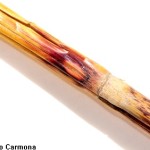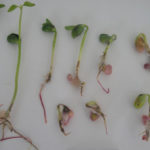.
Grupo de cultivos: Oleaginosas
Especie hospedante: Soja (Glycine max)
Rango de hospedantes: amplio, no específico. El patógeno es capaz de causar Fusariosis de la espiga en trigo (Triticum), la cebada (Hordeum), el arroz (Oryza), la avena (Avena) y la pudrición del tallo y la mazorca por Gibberella en el maíz (Zea). El hongo también puede infectar a otras especies de plantas sin causar síntomas de enfermedad. Otros géneros de hospedantes citados para Gibberella zeae o F. graminearum sensu lato son Agropyron, Agrostis, Bromus, Calamagrostis, Cenchrus, Cortaderia, Cucumis, Echinochloa, Glycine, Hierochloe, Lolium, Lycopersicon, Medicago, Phleum, Poa, Schyrium. Secale, Setaria, Sorghum, Spartina y Trifolium (Goswami y Kistler, 2004).
Etiología: Hongo. Necrotrófico
Agente causal: Fusarium graminearum (teleomorfo Gibberella zeae)
Taxonomía: Eukaryota > Fungi > Dikarya > Ascomycota > Pezizomycotina > Sordariomycetes > Hypocreales > Nectriaceae > Fusarium
.
La composición de especies de la población del complejo F. graminearum parece ser dependiente de la especie hospedantede y la localidad.
En Argentina se han identificado las especies F. graminearum sensu stricto, F. meridionale, F. cortaderiae y F. boothii como parte del complejo de especies agentes causales de la enfermedad (Barros et al., 2014; Chiotta et al., 2015; Chiotta et al., 2016).
En Canadá se han aislado las especies F. oxysporum Schlechtendahl emend. Snyder & Hansen, F. graminearum Schwabe, F. avenaceum (Corda: Fr.) Sacc., y F. tricinctum como parte del complejo de especies agentes causales de la enfermedad (Zhang et a., 2010).
En China se han identificado diferentes especies de Fusarium como parte del complejo de especies agentes causales de la enfermedad, incluyendo: F. fujikuroi, F. graminearum, F. proliferatum y F. incarnatum-equiseti basado en características morfológicas y análisis filogenéticos (Naeem et al., 2019).
.
Importancia relativa: en aumento.
.
Síntomas
Se observan decoloración y necrosis en la base del tallo y raíces. Las semillas presentan tegumento rosáceo. Se ha observado un incremento de su frecuencia en semillas. Fusarium graminearum también puede causar damping off (Ellis et al., 2011).
.
- Plántulas con diferentes síntomas causados por el aislamiento de F. meridionale F5030 a los 10 días después de la inoculación. Autor: Barros et al., 2014.
.
Manejo de la enfermedad
F. graminearum tiene capacidad de colonización saprofítica del rastrojo de numerosos cultivos tales como maíz y soja. Es por ello que este hongo constituye uno de los principales desafíos que enfrenta la siembra directa en la región ya que F. graminearum conquista todos los rastrojos de los principales cultivos bajo siembra directa. Se recomienda la siembra de variedades tolerantes (Ellis et al., 2012; Acharya et al., 2015; Marburger et al., 2017; Zhang et al., 2019). La rotación con cultivos de cobertura en combinación con el tratamiento eficiente de semillas puede disminuir el inóculo inicial de los campos infestados. Entre los principios activos fungicida se recomiendan captan y fludioxonil (Ellis et al., 2011).
.
.
Bibliografía
Acharya B, Lee S, Rouf Mian MA, et al. (2015) Identification and mapping of quantitative trait loci (QTL) conferring resistance to Fusarium graminearum from soybean PI 567301B. Theoretical and Applied Genetics 128(5): 827-38. doi: 10.1007/s00122-015-2473-5
Ashiq S, Edwards SG, Fatukasi O, et al. (2021) In vitro activity of isothiocyanates against Fusarium graminearum. Plant Pathology 00, 1– 8. doi: 10.1111/ppa.13505
Bakker MG, Brown DW, Kelly AC, et al. (2018) Fusarium mycotoxins: a trans-disciplinary overview. Canadian Journal of Plant Pathology 40(2): 161-171. doi: 10.1080/07060661.2018.1433720
Barros GG, Zanon MSA, Chiotta ML, et al. (2014) Pathogenicity of phylogenetic species in the Fusarium graminearum complex on soybean seedlings in Argentina. European Journal of Plant Pathology 138: 215–222. doi: 10.1007/s10658-013-0332-2
Bonacci M, Barros G (2019) Genetic diversity and pathogenicity on root seedlings from three soybean cultivars of Fusarium graminearum isolated from maize crop residues. Rev. Fca UNCUYO 51(1): 147-160. ISSN (en línea) 1853-8665.
Broders KD, Lipps PE, Paul PA, Dorrance AE. (2007) Evaluation of Fusarium graminearum Associated with Corn and Soybean Seed and Seedling Disease in Ohio. Plant Disease 91(9): 1155‐1160. doi: 10.1094/PDIS-91-9-1155
Cavinder B, Sikhakolli U, Fellows KM, Trail F (2012) Sexual development and ascospore discharge in Fusarium graminearum. J Vis Exp. (61): 3895. doi: 10.3791/3895
Chiotta ML, Alaniz Zanon MS, Giaj-Merlera G, et al. (2015) Phylogenetic analyses of the Fusarium graminearum species complex isolated from soybean in Argentina and Brazil. Australasian Plant Disease Notes 10: 32. doi: 10.1007/s13314-015-0182-1
Chiotta ML, Alaniz Zanon MS, Palazzini JM, et al. (2016) Pathogenicity of Fusarium graminearum and F. meridionale on soybean pod blight and trichothecene accumulation. Plant Pathology 65: 1492-1497. doi: 10.1111/ppa.12532
Chiotta ML, Alaniz Zanon MS, Palazzini JM, et al. (2021) Fusarium graminearum species complex occurrence on soybean and F. graminearum sensu stricto inoculum maintenance on residues in soybean-wheat rotation under field conditions. J Appl Microbiol. 130(1): 208-216. doi: 10.1111/jam.14765
Cuomo CA, Güldener U, Xu JR, et al. (2007) The Fusarium graminearum genome reveals a link between localized polymorphism and pathogen specialization. Science 317(5843): 1400-1402. doi: 10.1126/science.1143708
Del Ponte EM, Moreira GM, Ward TJ, et al. (2022) Fusarium graminearum Species Complex: A Bibliographic Analysis and Web-Accessible Database for Global Mapping of Species and Trichothecene Toxin Chemotypes. Phytopathology 112(4): 741-751. doi: 10.1094/PHYTO-06-21-0277-RVW
Dhokane D, Karre S, Kushalappa AC, McCartney C (2016) Integrated Metabolo-Transcriptomics Reveals Fusarium Head Blight Candidate Resistance Genes in Wheat QTL-Fhb2. PLoS One 11(5): e0155851. doi: 10.1371/journal.pone.0155851
Ellis ML, Broders KD, Paul PA, Dorrance AE (2011) Infection of Soybean Seed by Fusarium graminearum and Effect of Seed Treatments on Disease Under Controlled Conditions. Plant Disease 95(4): 401‐407. doi: 10.1094/PDIS-05-10-0317
Ellis ML, Wang H, Paul PA, St. Martin SK, McHale LK, Dorrance AE (2012) Identification of Soybean Genotypes Resistant to Fusarium graminearum and Genetic Mapping of Resistance Quantitative Trait Loci in the Cultivar Conrad. Crop Science 52: 2224-2233. doi: 10.2135/cropsci2011.11.0624
Hafez M, Abdelmagid A, Aboukhaddour R, et al. (2021) Fusarium Root Rot Complex in Soybean: Molecular Characterization, Trichothecene Formation, and Cross-Pathogenicity. Phytopathology:PHYTO03210083R. doi: 10.1094/PHYTO-03-21-0083-R
King R, Urban M, Hammond-Kosack MC, Hassani-Pak K, Hammond-Kosack KE (2015) The completed genome sequence of the pathogenic ascomycete fungus Fusarium graminearum. BMC Genomics 16(1): 544. doi: 10.1186/s12864-015-1756-1
Krishnan SV, Anaswara PA, Nampoothiri KM, et al. (2025) Biocontrol Activity of New Lactic Acid Bacteria Isolates Against Fusaria and Fusarium Mycotoxins. Toxins 17(2): 68. doi: 10.3390/toxins17020068
Lu C, Zhang H, Wang Y, et al. (2015) Rapid diagnosis of Fusarium root rot in soybean caused by Fusarium equiseti or Fusarium graminearum using loop-mediated isothermal amplification (LAMP) assays. Australasian Plant Pathology 44: 437–443. doi: 10.1007/s13313-015-0361-8
Marburger DA, Smith DL, Conley SP (2017) Impact of Fusarium graminearum on early-season soybean growth and seed yield under field conditions. Canadian Journal of Plant Pathology 39: 464-474. doi: 10.1080/07060661.2017.1378727
Martinelli J, Bocchese C, Rosewich Gale L, Xie W, O’Donnell K, Kistler HC (2001) Soybean is a host for Fusarium graminearum [online]. In 2001 National Fusarium Head Blight Forum Proceedings. 8–10 December 2001, Holiday Inn Cincinnati-Airport, Erlanger, Ky. Compiled by S.M. Canty, J. Lewis, L. Siler, and R.Ward, Michigan State University, East Lansing, Mich. Organized by US Wheat and Barley Scab Initiative. Printed by Kinko’s, Okemos, Mic. Link
Martinelli JA, Bocchese CAC, Xie W, O’Donnell K, Kistler HC (2004) Soybean pod blight and root rot caused by lineages of the Fusarium graminearum and the production of mycotoxins. Fitopatologia Brasileira 29(5): 492-498. doi: 10.1590/S0100-41582004000500004
Modrzewska M, Bryła M, Kanabus J, Pierzgalski A (2022) Trichoderma as a biostimulator and biocontrol agent against Fusarium in the production of cereal crops: opportunities and possibilities. Plant Pathol. doi: 10.1111/ppa.13578
Naeem M, Li H, Yan L, Raza MA, Gong G, Chen H, Yang C, Zhang M, Shang J, Liu T, Chen W, Faheem Abbas M, Irshad G, I Khaskheli M, Yang W, Chang X (2019) Characterization and Pathogenicity of Fusarium Species Associated with Soybean Pods in Maize/Soybean Strip Intercropping. Pathogens 8(4): 245. doi: 10.3390/pathogens8040245
O’Donnell K, Whitaker BK, Laraba I, et al. (2022) DNA Sequence-Based Identification of Fusarium: A Work in Progress. Plant Disease 106(6): 1597-1609. doi: 10.1094/PDIS-09-21-2035-SR
Pioli RN, Mozzoni L, Morandi EN (2004) First Report of Pathogenic Association Between Fusarium graminearum and Soybean. Plant Disease 88(2): 220. doi: 10.1094/PDIS.2004.88.2.220A
, , , (2021) A natural two-nucleotide deletion affirms role for NADPH oxidase in pathogenicity and perithecium formation in Fusarium graminearum species complex. Plant Pathology 00: 1– 9. doi: 10.1111/ppa.13499
Vicente I, Quaratiello G, Baroncelli R, et al. (2022) Insights on KP4 Killer Toxin-like Proteins of Fusarium Species in Interspecific Interactions. Journal of Fungi 8(9): 968. doi: 10.3390/jof8090968
Zhang C, Zhao X, Qu Y, et al. (2019) Loci and candidate genes in soybean that confer resistance to Fusarium graminearum. Theoretical and Applied Genetics 132(2): 431‐441. doi: 10.1007/s00122-018-3230-3
Zhang JZ, Xue AG, Zhang HJ, Nagasawa AE, Tambong JT (2010) Response of soybean cultivars to root rot caused by Fusarium species. Canadian Journal of Plant Science 90: 767-776. doi: 10.4141/CJPS09133
Zhang L, Sun K, Li Y, et al. (2022) The Importin FgPse1 Is Required for Vegetative Development, Virulence, and Deoxynivalenol Production by Interacting with the Nuclear Polyadenylated RNA-Binding Protein FgNab2 in Fusarium graminearum. Phytopathology 112(5): 1072-1080. doi: 10.1094/PHYTO-08-21-0357-R
, , , et al. (2021) Microtubule‐assisted mechanism for toxisome assembly in Fusarium graminearum. Molecular Plant Pathology 22: 163– 174. doi: 10.1111/mpp.13015

